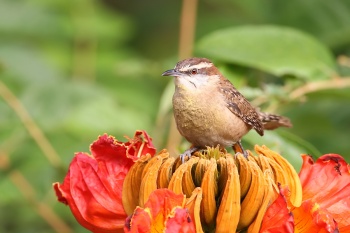- Thryothorus ludovicianus
Identification
12·5–14 cm (5-5½ in)
- White supercilium flaring at the end
- Down-curved bill
- Cinnamon upperparts
- Buffy underparts
- Some speckling on wings
- Tail is barred
Regional variation: the southern form of Carolina Wren (White-browed Wren) from the Yucatan peninsula and Guatemala differs in having upperparts less rufous, underparts whitish to buff, and lack the barring on the flanks (or at least have this strongly reduced).
Similar species
May be confused with Bewick's Wren, but note buffy underparts rather than grey (Bewick's).
Distribution
Eastern USA, south of Ontario and Quebec, Canada, and northeast Mexico. A separate population is centered on the Yucatan peninsula (southern Mexico, Belize, Guatemala and western Nicaragua.
Taxonomy

Photo © by Stanley Jones
Lick Creek Park, College Station, Brazos County, Texas, USA, May 2013
The closest relative of Carolina Wren is Bewick's Wren.
Subspecies
Nine subspecies are recognized[1]:
- T.l. ludovicianus:
- T.l. miamensis:
- Peninsula Florida
- T.l. nesophilus:
- Dog Island (off north-western Florida)
- T.l. burleighi:
- Cat Island, Ship Island and Horn Island (off Mississippi)
- T.l. lomitensis:
- T.l. berlandieri:
- Mountains of eastern Mexico (eastern Coahuila, Nuevo León and south-western Tamaulipas)
- T.l. tropicalis:
- Tropical north-eastern Mexico (southern Tamaulipas and eastern San Luis Potosí)
- T.l. albinucha:
- South-eastern Mexico (Yucatán Peninsula) to Petén of northern Guatemala
- T.l. subfulvus:
- Arid interior of Guatemala to north-western Nicaragua
The Clements checklist divides these subspecies into three groups, of which the southernmost group (consisting of the last two subspecies) has been recognized as a full species (White-browed Wren Thryothorus albinucha) by some authors[2].
Habitat
Prefers areas with bushes; can be found in forests, swamps, residential areas.
Behaviour
Diet
The diet includes spiders and insects.
Breeding
Its nest is a domed cup with a side entrance, made from bark, dried grasses, dead leaves, hair, and feathers. The 3-7 brown-spotted cream eggs are incubated for 12-16 days.
Vocalisation
Song: Loud, rolling song sometimes written as teakettle teakettle teakettle. Many variations, all rolling with a medium tempo and repetition.
Both male and female sing.
Call: Scolding call a harsh cheh cheh cheh...
References
- Clements, J. F., T. S. Schulenberg, M. J. Iliff, S. M. Billerman, T. A. Fredericks, B. L. Sullivan, and C. L. Wood. 2019. The eBird/Clements Checklist of Birds of the World: v2019. Downloaded from http://www.birds.cornell.edu/clementschecklist/download/
- Lepage D. (2021) [Avibase - https://avibase.ca/5217F951 ]. Retrieved 28 April 2021
- Paper describing DNA analysis of the "Thryothorus" wrens
- Howell, SNG and S Webb. 1995. A Guide to the Birds of Mexico and Northern Central America. New York: Oxford Univ. Press. ISBN 978-0198540120
- All About Birds
- Wikipedia
Recommended Citation
- BirdForum Opus contributors. (2025) Carolina Wren. In: BirdForum, the forum for wild birds and birding. Retrieved 3 May 2025 from https://www.birdforum.net/opus/Carolina_Wren
External Links
GSearch checked for 2020 platform.1






